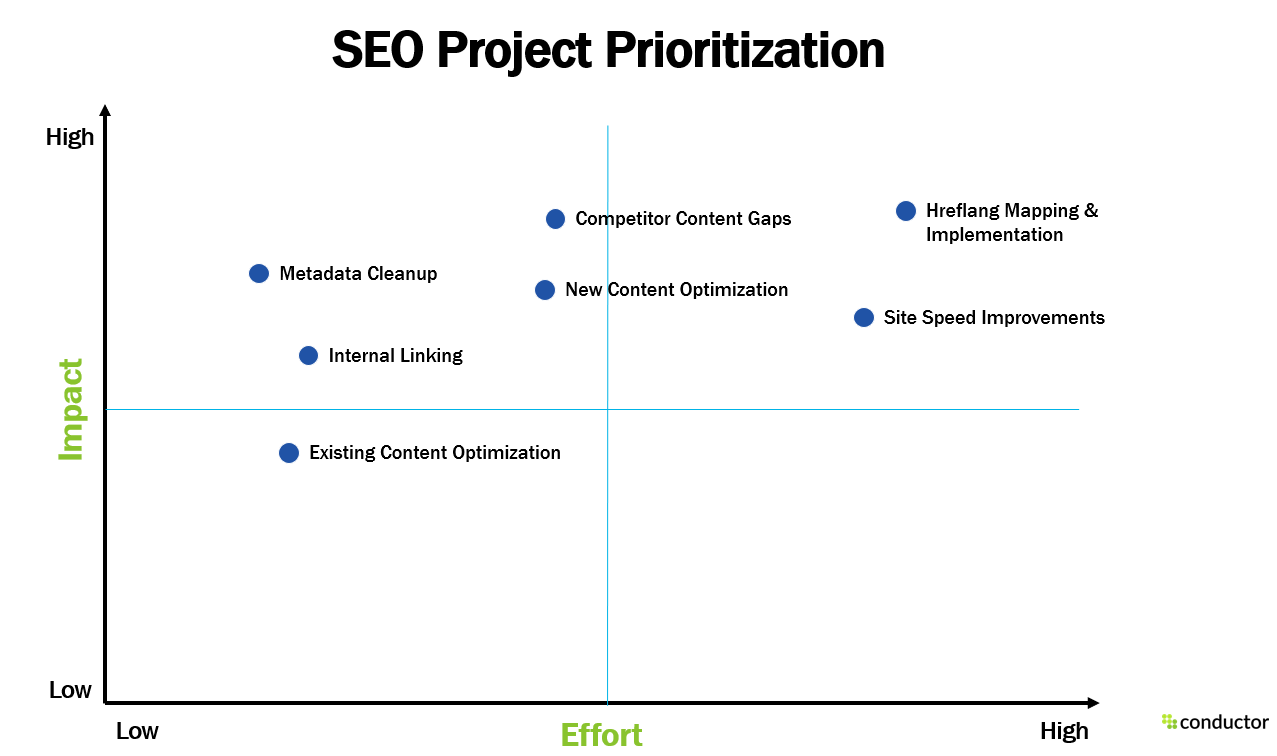Oftentimes in the SEO community and industries in general, the concept of “enterprise SEO” is associated with website size rather than organization size.
When in reality, enterprise SEO is a large-scale, strategic approach to search in an organization.
There is no hard-pressed rule where if you have X number of employees, you’ve now crossed over to the “enterprise” band.
Large corporations often have a global presence with customers and teams of employees around the world. When your business is operating at scale, your SEO should be, too.
A global enterprise insurance company with $30 billion in annual revenue may have over 30,000 employees in 20 countries, covering 10 industries with a website that totals 20K pages.
Being able to grow and measure your search presence across all regional sub-directories or ccTLDs takes a strategic approach.
When it comes to enterprise SEO, one hurdle that stands in many businesses’ way is a strategic approach for international SEO.
While global digital marketing has made it easy for brands to reach audiences around the globe, it takes more than just a website and access to Google Translate to be successful.
There is no shortage of articles on how to win at international SEO or a number of professionals who’ll tell you they’re your international SEO guru.
Don’t worry, that’s not what this is: some quick fix that’ll solve all your problems.
What follows is the outline of a strategic approach to face the real challenge of building an enterprise SEO program that can scale globally.
A Scalable Program Built for Success
Moving the SEO needle for an enterprise business with a global presence requires a sophisticated, fine-tuned, and scalable approach.
This approach starts with building a program.
For businesses spread out across the world, having a global SEO lead is the easiest way to get a program up and running.
This person or small team will work in close liaison with digital teams across the global org.
They should also be responsible for providing training for regional digital teams, getting processes implemented, and (maybe most importantly) evangelizing SEO throughout the org.
A challenge that lies with having many digital teams around the world is they may take a different approach to SEO.
One region may have a team of three members dedicated to search while others’ only resource is a manager of demand gen who juggles multiple channels.
Teams in different countries may use different tools, vendors, or agencies, and have various levels of training.
What should remain consistent are SEO principles and defined maturities.
Learn as Much as You Can
Before you start to define levels of SEO maturity, make sure you have insight into the current state of affairs in all your markets.
Creating a survey to distribute to every team is an easy way to get most of the information you need without needing to schedule weeks of meetings.
Here’s a sample of some questions to include in the survey:
- How do you currently measure SEO?
- What tools does your team utilize?
- Describe your content creation process
- What are your top SEO initiatives over the next 90 days?
- What is the process for implementing technical fixes and recommendations?
Keep a record of all results and re-distribute the survey annually.
Make sure to adjust the questions as needed over time.
Defining SEO Maturity
Defining levels of SEO maturity within a system of measurement is critical to achieving global success.
Maturity should be based around SEO principles consisting of three values: people, process, and platforms.
These will be the building blocks of your program, and how you measure maturity across markets.
People
To measure your “People”, define different maturity levels that describe personnel, executive engagement, and training.
For example, “Level 1” for training could be defined as “Little internal training, some materials available but not utilized”, while “Level 5” could be “Advanced training and certifications are available and a key component of professional development”.
Process
To measure “Process”, define different levels of KPIs, communication, and strategic direction.
A Level 1 KPI could be defined as “No KPIs exist for SEO, visibility of organic search performance is limited” while level 5 could be “KPIs are common language and shared globally”.
Platform
To measure “Platform”, define different levels of measurement/reporting, standardization, and technology integration.
“Level 1” standardization could be defined as “Teams use no tools/platforms or choose their own.
No standardization exists”, while “Level 5” could be “All necessary data integrated into tools/platforms. Holistic view of performance is leveraged.”
Benchmarking with Report Cards
An effective way to report out on these SEO maturities along with content and technical health is through the creation and distribution of scorecards.
Collaborate with internal designers and the best data storyteller in your office to develop a template that measures success and benchmarks maturities of each market.
It’s up to you or your leaders to determine the cadence at which SEO should be reported, but I’ve found that generating and distributing scorecards quarterly has been effective.
Don’t Let Roadblocks Slow You Down
Being able to effectively roll out a program is not an easy feat as there are plenty of potential barriers along the way. Common challenges include:
- Personnel
- Training
- Goal setting
- Prioritization
- Timing
- Measurement
- Buy-In
Personnel
Teams come in all shapes and sizes, and you’ve got to be able to work with what you’ve got.
The SEO strategy you helped develop for your team of five in the U.K. will likely have to be adapted to work for your team of one in Argentina.
Taking the time upfront to learn about the intricacies of each team will help you immensely in the long run.
Training
Training across markets should remain as consistent as possible.
Some teams might need SEO 101 while others may be ready to jump into an advanced technical SEO workshop.
If your organization has an internal learning and development team, work with them to develop an SEO curriculum.
Organized training for any tools or platforms utilized is also crucial.
If your organization has made investments into SEO technology, it’s our job to ensure they will see positive ROI.
This will also make it easier to quickly get a budget for any flashy new tools that may come out in the future.
Goal Setting
Not all teams, audiences, and websites are created equal.
This must be taken into account when setting goals.
Based on what you have learned about each team, work with their leaders to set attainable goals.
Nobody should be expecting an international site riddled with technical issues and no content strategy to achieve page one wins overnight.
However, the goals you set should push the team out of their comfort zone.
This could be a siloed content marketer collaborating with someone on the dev team to eliminate render-blocking resources and compress files.
Prioritization
As SEO professionals, it’s easy to fall into a state of constantly feeling overwhelmed.
A site crawl can come back with 15+ issues, your site migration or redesign checklist might be five pages long, your content strategy may be starting from the ground level, and the list goes on.
Being able to prioritize efficiently tends to be a neglected skill in many fields, especially in SEO.
Prioritization can key to getting some quick wins which will help gain the trust and budget necessary for long-term success.
I like to start by identifying all known projects/initiatives and place them into a chart that maps each item to their level of effort and impact.
From there, I can use this visual to align them in my SEO roadmap that gets updated on a quarterly basis.
Timing
Being realistic when it comes to SLAs and turn around time is imperative for any productive engagement.
Success doesn’t happen overnight, and neither should your projects. Expectations should be set for both the completion of work, and when results should start to show.
Being able to communicate timelines and have others understand what goes into the work you’re doing requires effective and open communication.
Measurement
No matter how complex your approach, the end results need to be easily digestible by a wide audience.
Effectively measuring the impact of your hard work and ongoing refinement is not only critical to your SEO success, but also to your perceived value.
SEO professionals are often bombarded with tons of data to analyze, which comes with an increased difficulty to reach cut-and-dry conclusions.
To help get a handle on this, make sure your data is prioritized into information that is important for your particular business.
Subscribe for Daily Search Insights
AI, PPC, and digital marketing news distilled to fuel success. Join the other 75k marketers!
Because data can become so overwhelming, I try to build dashboards that lay everything out into one easily-digestible view.
Buy-In
Building your internal brand for SEO starts by getting a seat at the table.
It’s critical that other team members understand how their job affects SEO, and that executives understand how SEO affects their job.
Oftentimes, having a voice starts with having success.
If a market has made some serious non-branded ranking improvements, put together an internal presentation on how organic rankings can allow the brand to cut back paid spend, or now have the ability to be more creative and test different paid strategies knowing organic is there as a fail-safe.
One of the biggest roadblocks to implementing and scaling an SEO program is finding the right support.
If you do not have internal stakeholders in your corner, you may not be taken seriously when trying to work with other markets.
Finding the right internal support can be a challenge as we often must deal with other marketers who have not yet bought into organic search.
Being able to demonstrate wins and build cross-functions relationships will help achieve that buy-in from up top
Everything you create should also have actionable takeaways.
Create insights and recommendations tailored to each market on their scorecard.
A Recipe to Make Your Own
There is no secret recipe for how to win at global enterprise SEO, but there are several ingredients necessary for success.
What we’ve outlined is a loose recipe that can be tinkered with and updated based on taste.
What is good for one company may not be good for the next.
At the end of the day, having a program tailored to your brand, teams, and resources that can be effectively measured will give you the best chance to succeed on a global scale.
More Resources:
- Enterprise SEO Guide: Strategies, Tools, & More
- The Business of Enterprise SEO: Mastering People, Process & Platforms
- Global vs. Local Websites: Which Is Right for You?
Image Credits
In-Post Images #1 & #3: iStock
In-Post Image #2: Conductor





